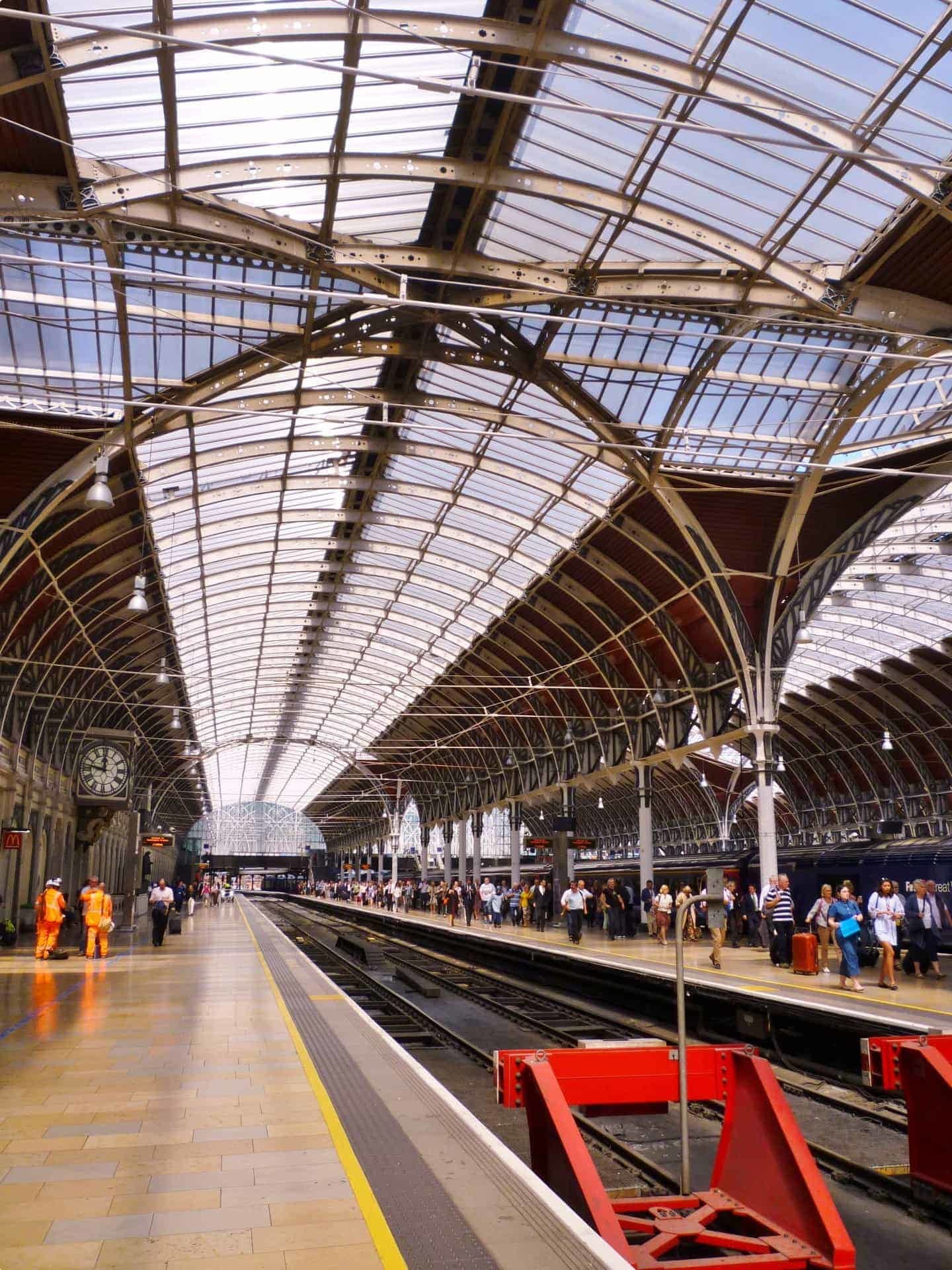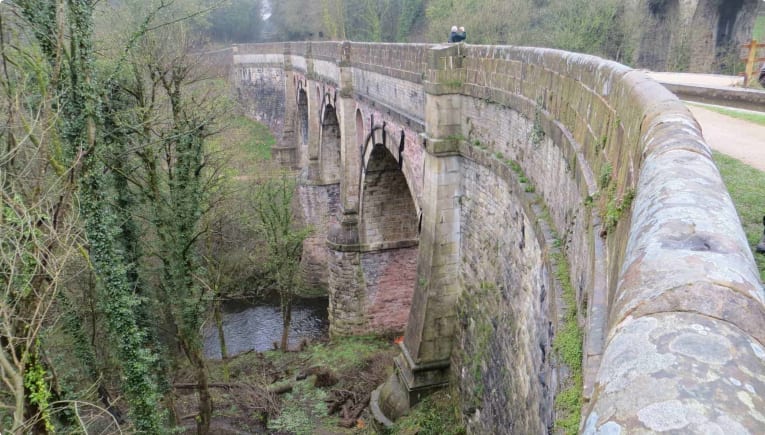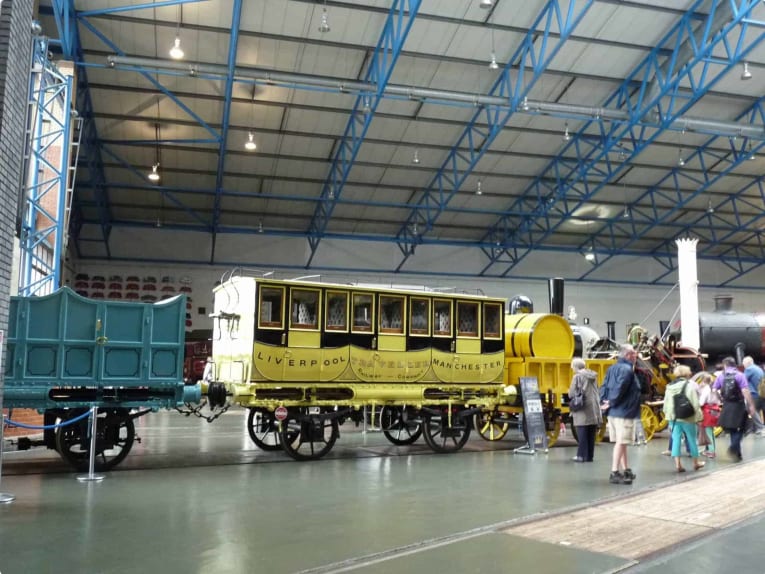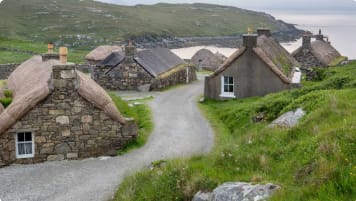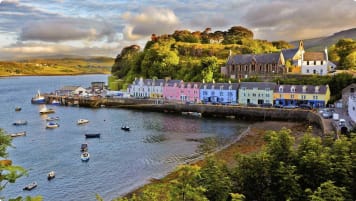Industrial Revolution. Britain's contribution to the world
Britain and the industrial revolution. A progressive period that spanned Queen Victoria's period. Small group package tours for mature and senior travellers explore this fascinating period of history across England and Scotland and key cities such as Manchester, Liverpool, Newcastle and Glasgow.
9 Oct 17 · 36 mins read
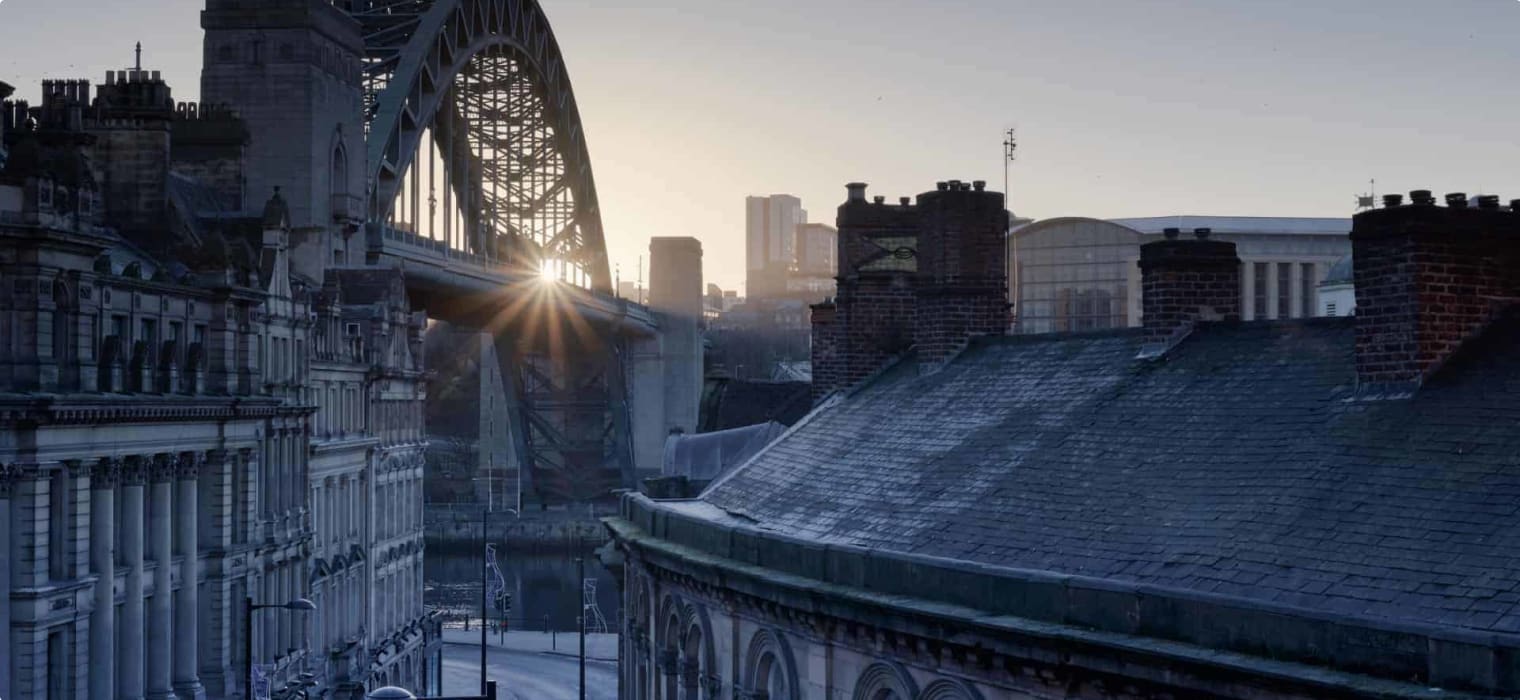
Industrial Revolution. Britain’s contribution to the world
Entrepreneurial thought, cheap high energy yielding, coal, the harnessing of steam to do work and a surplus of child labour as a result of the mechanisation of farming came together simultaneously in Britain. The result was the Industrial revolution, a period that shaped the next century.
Britain’s canals and railways
The canal systems and railways of Britain tell a history of the Industrial Revolution. By tracking these systems, and reflecting on their impacts across time, it is possible to traverse some of the most beautiful regions of Great Britain. Odyssey Traveller’s Exploring Britain through its Canals and Railways tour is designed for senior and mature travellers who are interested in learning about the places they visit. Our small group tours include an experienced guide to provide context and access to locations off the beaten track. For more information on all of our tours to the UK, click here. If you would like to contact us about this, or any other of our small group tours, please call or send an email. We’d love to hear from you!
The Industrial Revolution
The Industrial Revolution resulted in Britain becoming the world leader in trade of produced goods. This was made possible through the invention and development of machinery and techniques for mass manufacture, and the acquisition of raw materials and new sources of energy. In addition to its industrial impacts, the revolution also heralded new opportunities for social connection. People departed rural hamlets and villages and formed the labour force in rapidly expanding cities like Manchester and Newcastle. These workers relied on their wages to cover expenses of living. Women and children, too, worked long hours. As real wages began to increase, the old-days of self-reliance gradually disappeared.
The consequences of the Industrial Revolution are still palpable in today’s Great Britain. Relics from the early 18th to mid-19th century remain, though their purposes have evolved. Many of the canals have been restored and now support recreational boating. And sections of the original railway network trace trips through spectacular British landscapes. Historic features associated with the Industrial Revolution endure across Britain. These include original factories and associated workers’ housing, which are heritage listed. Several outstanding museums house other pieces of history to be discovered.

The Industrial revolutions legacy of canals & railways
Given that both canals and railways must operate on relatively flat gradients, engineers and architects of the day were required to design novel structures that would allow passage across valleys, up and down slopes, and through mountains. The people of Georgian and Victorian times rose to the occasion in their masses. This was construction on a mammoth scale. Collectively their work resulted in remarkable constructions and inventions, including the Pontcysyllte aqueduct, flights of locks like Neptune’s Staircase, the 24-arch Ribblehead railway viaduct, and the steam locomotive.
We are so fortunate that today, we can still experience these masterpieces. We can marvel at the ingenuity of the first locomotives that ran on the railway at Darlington and between Liverpool and Manchester. We can ponder the fascinating boat-lifting devices like the Anderton Boat Lift. And we can admire the many architectural splendours of the time, including the restored 1860s’ London terminus of the Midlands Railway, St Pancras. All of these heritage listed buildings and artefacts the result of an incredible amount of labor required to build these facilities to enable this industrial revolution to proceed.
“Canal mania”
‘Canal mania’ in Britain started after the opening of Bridgewater in 1763. Some 3,520 kilometres were constructed over the next 60 years. Canal development, as the new corridor for British transport, prospered in the 1790s, but were eventually overshadowed by a new technology. The new technology was the steam train for the railway. Railways endured from their peak of development in 1845 until the economic austerity measures of 1963 forced massive closures of line branches and stations.

“Railway mania”
It was the opening of the Liverpool Manchester inter-city railway that began Great Britain’s ‘railway mania’. Thousands of kilometres of line were laid in just a few years using teams of navvies, many of whom had parents who had worked during the earlier ‘canal mania’ years. By 1844, some 3,576 kilometres of line was distributed over more than 100 routes. By 1847, this volume multiplied dramatically. Over 15,000 kilometres of lines traversed Britain, representing 90% of the rail network that exists today.
The canal and railway networks were vital to the development of factories. They facilitated the movement of raw materials like coal, salt, imported cotton, and manufactured goods such as pottery and iron products. But the railways also made it possible for people to move in large numbers. The Industrial Revolution saw the rise of middle class businessmen, while the working class received wages from their mill and factory employment. An interesting consequence of these opportunities was the explosion of holiday destinations like Blackpool, Morecambe and Windermere. These locations opened up to all ‘day trippers’ and ‘lodgers’, not just to the privileged rich members of British society.
There were effects both great and small. Suddenly, fresh fish could be bought in inland towns. The military forces started moving their troops by rail, and Queen Victoria and Prince Albert were to have a line to Windsor Castle west of London. Later, their entourage used trains to reach their favourite Balmoral Castle in Scotland. The rail network transformed the daily lives of all classes of people.
Key players in the history of Britain’s Industrial revolution
Many people were involved in conceiving, surveying, designing and engineering the canals and early railways of Britain, and in developing factory machines that enabled mass production of goods. Several of these same people also saw the need to provide appropriate housing and community facilities for the people who worked for them in the newly-developed factories.
Read on for a list of selected personnel who were involved in the Industrial Revolution, though many more people brought about change that has impacted Great Britain.
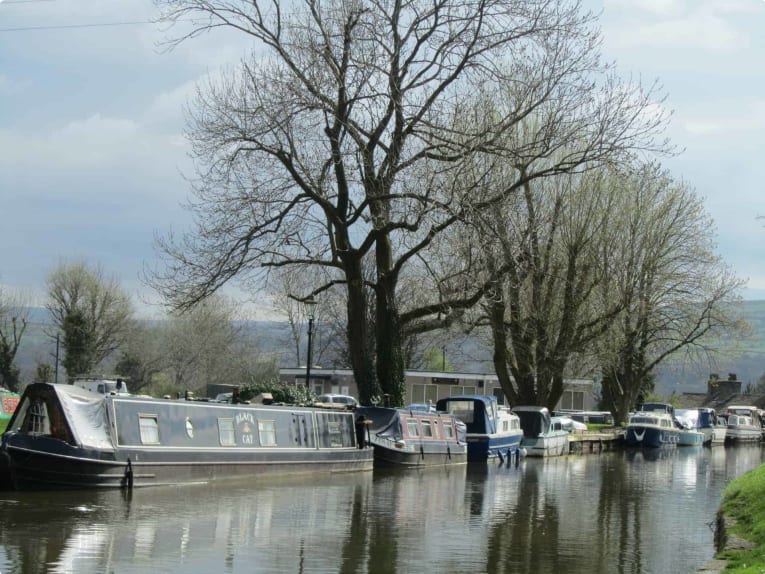
1. James Watt
(30 January 1736 – 25 August 1819)
Watt was a Scottish inventor, mechanical engineer, and chemist who improved on Thomas Newcomen’s 1712 Newcomen steam engine with his Watt steam engine in 1781. This engine was fundamental to the changes brought by the Industrial Revolution in both his native Great Britain and the rest of the world.
While working as an instrument maker at the University of Glasgow, Watt became interested in the technology of steam engines. He realised that contemporary engine designs wasted a great deal of energy by repeatedly cooling and reheating the cylinder. Watt introduced a design enhancement, the separate condenser, which avoided this waste of energy and radically improved the power, efficiency, and cost-effectiveness of steam engines. Eventually, he adapted his engine to produce rotary motion, significantly broadening its use beyond pumping water.
Watt attempted to commercialise his invention, but experienced great financial difficulties until he entered a partnership with Matthew Boulton in 1775. The new firm of Boulton and Watt was eventually highly successful and Watt became a wealthy man. In his retirement, Watt continued to develop new inventions, though none was as significant as his steam engine work. He died in 1819 aged 83.
2. Richard Trevithick
(13 April 1771 – 22 April 1833)
Trevithick was a British inventor and mining engineer from Cornwall, England. The son of a mining captain, and born in the mining heartland of Cornwall, Trevithick was immersed in mining and engineering from an early age. He performed poorly in school, but went on to be an early pioneer of steam-powered road and rail transport. His most significant contribution was the development of the first high-pressure steam engine. He also built the first full-scale working railway steam locomotive. On 21 February 1804, the world’s first locomotive-hauled railway journey took place as Trevithick’s unnamed steam locomotive hauled a train along the tramway of the Penydarren Ironworks, in Merthyr Tydfil, Wales.
3. Abraham Darby I, II & III
Darby I pioneered the use of coke in iron-making (smelting) at a blast furnace he had leased in 1708 at Coalbrookdale (just east of Shrewsbury). He made pig iron which was used in cast iron goods like pots and kettles and some other structural materials. Abraham Darby I and his descendants were socially conscious Quakers and built worker housing, a school for boys and a corn mill at upper Coalbrookdale.
His son Abraham Darby II in the 1740s produced pig iron that could be converted into wrought iron (bar iron), a much more malleable form of the metal. In 1755 he developed this process in a completely new ironworks just north of Coalbrookdale where he had two blast furnaces.
And finally the third generation Abraham Darby III was not only a leading ironmaster in the Coalbrookdale area, but was responsible for producing the cast iron used in building the famous Iron Bridge (1779) that had been designed by Thomas Pritchard.

4. Richard Arkwright
As the “Father of the Factory System”, Arkwright built Derwent Valley cotton mills at Cromford (just south of Manchester) in 1771 and 1791, and at Matlock Bath in 1783. The mill at Cromford was the world’s first successful water-powered cotton spinning mill. Arkwright was also to build housing for his millworkers and community facilities near the mill.
5. Jedediah Strutt
In 1786, Strutt began building mills at Belpar (further south in the Derwent Valley). By replacing the timber in their framework with cast iron, he constructed the first fire-proof building. North Mill was the first to be built in 1804. Like Arkwright, Strutt also built millworker housing, farms, a church and other public buildings close to his mills.
6. James Brindley
Brindley was an ingenious engineer who assisted the Duke of Bridgewater in developing one of the first British canals that was independent of any river. It had the purpose of carrying coal from the Duke’s coal mine into Manchester city. Completed in 1761, this canal became a model for the new forms of transport and inspired many industrialists to invest in canal development. Later, Brindley had a vision to link the Rivers Thames and Severn with the Trent and the Mersey. He went on to play a major role in canal-building, his work including the Trent Mersey Canal, with the completion of the other links occurring some 18 years after his death in 1772. A national network of canals had resulted by about 1820.

7. John Rennie
(1761 – 1821)
Rennie was a civil engineer involved in the construction of many canals, bridges and harbours in England, Wales, Scotland and Ireland from his professional base in London. During Odyssey’s small group Britain’s History through its Canals and Railways tour, we shall see the Lancaster Canal that began construction in 1792. This was one of Rennie’s earliest achievements.
8. Thomas Telford
(1757 – 1834)
Like Rennie, Telford was born in Scotland and was the last of the great canal-building engineers. He took on this role with the Shropshire Canal (originally called the Birmingham and Liverpool Junction Canal) in 1835. In the history of Britain’s canals and railways, Telford is somewhat of a hero. You will note his constructions popping up in England, Wales and Scotland (He also has some in Sweden!). Telford began his working life as a stonemason and from this base, developed architectural and engineering skills which were used to produce aqueducts including the spectacular Pontcysyllte over the River Dee in Wales, bridges in the mid-west of England, North Wales at Menai and in Scotland.
Telford engineered roads such as the section of the London road between Shrewsbury and Holyhead (in western Wales) and in the Highlands and Lowlands of Scotland. He was also responsible for the development of several canals including the Caledonian Canal through the Great Glen of Scotland, and the Llangollen (originally called the Ellesmere) Canal (in conjunction with William Jessop) through the West Midlands of England.
9. George & Robert Stephenson
This father and son team played a leading role in the development of railway tracks and in the engineering of steam engines that were to move the rolling stock. The standard gauge railway line (4 foot 8 ½ inches), the development of iron rails, and engineering the important London to Birmingham Railway linking the capital to the midlands and north-west, may be attributed to George Stephenson. Many improvements in the engines and their efficiency, including the multi-tube boiler, were the ideas of Robert.
For the most part, their manufacturing base was in Newcastle-on-Tyne. Initially, they made steam locomotives for coal mines, and it was their engines that were used in 1825 on the first steam-hauled public Stockton and Darlington Railway (located south of Durham). Five years later, their collective ideas and engines were also used on the first inter-city railway between the port of Liverpool and the rapidly developing, industrial town of Manchester.
10. Isambard Kingdom Brunel
(1806-1859)
Brunel was born in 1806 to an émigré father of French descent, who worked as an inventor and engineer in England. He was a proud man, and counted George Stephenson as his only professional equal. Brunel, after training in engineering, went on to complete tunnelling works under the Thames, as well as bridge construction and the development of the Great Western Railway between London and Bristol, which was approved for construction in 1833. Brunel shirked Stephenson’s widely-adopted lead: he calculated that a 7 foot ¼ inch gauge would be best for speed and comfort on his railway line. The railway project was eventually completed at double the estimated cost and nearly two years late. But express trains on this line were to reach record breaking speeds of 80 km/h over the 171 kilometre journey.
At Paddington today, Brunel’s original 1854 three-span roof covers platforms 1 – 8. There have been many additions to the building over the years, and today it serves as the city junction for the Heathrow Express service. Later in life, Brunel went on to design steam ships, the first of which became the first trans-Atlantic steamer. After a few disasters, his second steamer was directed to the Australian run, carrying some 600 emigrants with a return load of bullion. This service lasted 23 years. Brunel died in 1859.
11. The navvies
Navvies were group of labourers responsible for the construction work on the railways and canals. It was the navvies, through their manual labour with a spade and wheelbarrow, that dug the canal channels, built the bridges, aqueducts, viaducts and embankments, and blasted and excavated the tunnels. The term derives from navigators.
Navvies worked in large groups. A labour force of 1,000 – families included – were involved in the construction of the Ribblehead Viaduct, for example. In total, navvies were to play a vital role for over 150 years in British history: from the first canals, through the ‘railway mania’ period and beyond.
While most navvies were British in origin, with large contingents from Ireland and Scotland, they were later joined by people of European descent. They formed a distinct social group, living near the job in shanty towns; they were heavy drinkers of beer and porter and wore distinctive clothing including rainbow waistcoats, moleskin trousers and sealskin caps. For more information on the navvies, visit the UK’s Canals and River Trust website. This resource also details the upkeep and protection of this important part of the region’s history.
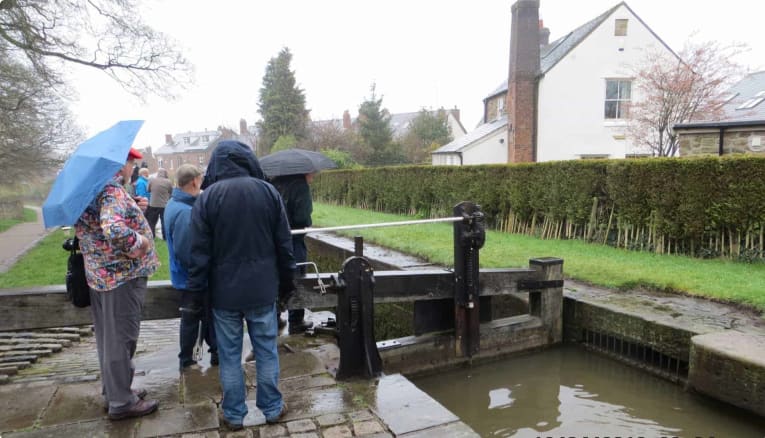
Key sites in the history of Great Britain’s canals and railways
The following is a list of key sites in the history of these impressive systems, and stops and sites between them. They form a fascinating and picturesque route through Britain.
Manchester
The Manchester region was the centre of great developments during the Industrial Revolution. Cotton fabric was produced from mills powered by local coal, and was moved using the growing network of canals that terminated or passed through the expanding city. Later, railways allowed for the more efficient movement of materials, products and manpower to and from the factories. Many of the newly formed railway companies bought the rights to the canals.
The Manchester Ship Canal runs parallel to the Mersey River and made Manchester the most significant port, inland from seaside Liverpool. Downstream, Merseyside docks at Liverpool and Birkenhead handled larger proportions of cargo, but Salford in Manchester was a major junction for canals. Particularly those associated with cotton spinning and weaving in local mills during the 18th and 19th centuries. Since then, there has been a great reduction in shipping traffic, and the Manchester docks were closed in 1982. Consequently, some of the docks have been drained and filled. Others, however, have been cleaned up and are now sites for housing, businesses and museums.
Must-see in Manchester
While in Manchester, be sure to check out:
- the refurbishment and reconstruction of the once derelict Salford Quays that has been billed as one of the finest regeneration projects in Britain
- there are many major shop outlets here, along with low and high-rise residential areas
- Media City UK, including the BBC
- the Imperial War Museum
- water-based clubs
- several lovely water bodies and fixtures formed from the old dock basins
- plus interesting new bridges like the Millennium Bridge.
- Manchester is also home to the world’s first railway station, Liverpool Road, and this is located within the grounds of the Museum of Science and Industry (MOSI). The museum has several exhibitions associated with the theme of this program. This includes artefacts of the L&MR, the Textiles exhibition and the Power section.
Manchester to Shrewsbury
The town of Marple is located on the south-eastern edge of Greater Manchester. Marple is rich in canal history with the Grand Aqueduct that carries The Peak Forest Canal over the River Goyt, and the impressive flight of the 16 Marple locks. Today, the Peak Forest, the Macclesfield, the Trent & Mersey, the Bridgewater and a small section of the Huddersfield canals form a popular waterway circuit for narrow boat enthusiasts.
Close-by, on the Cheshire Plains at Winsfield, underground salt has been recovered since Roman times. An expansion of the industry in the mid-1800s relied on canal transport and a lift of over 15 metres between two waterways to export the salt. To accommodate this, the Anderton Boat Lift was devised and built near Northwich in 1875, enabling vessels from the River Weaver Navigation to transfer with their load of salt to the Trent & Mersey Canal. Although the actual lifting mechanisms (hydraulics and winding machinery) have been altered several times over the 125+ year lifetime of the lift, the massive superstructure was recently restored and continues to function.
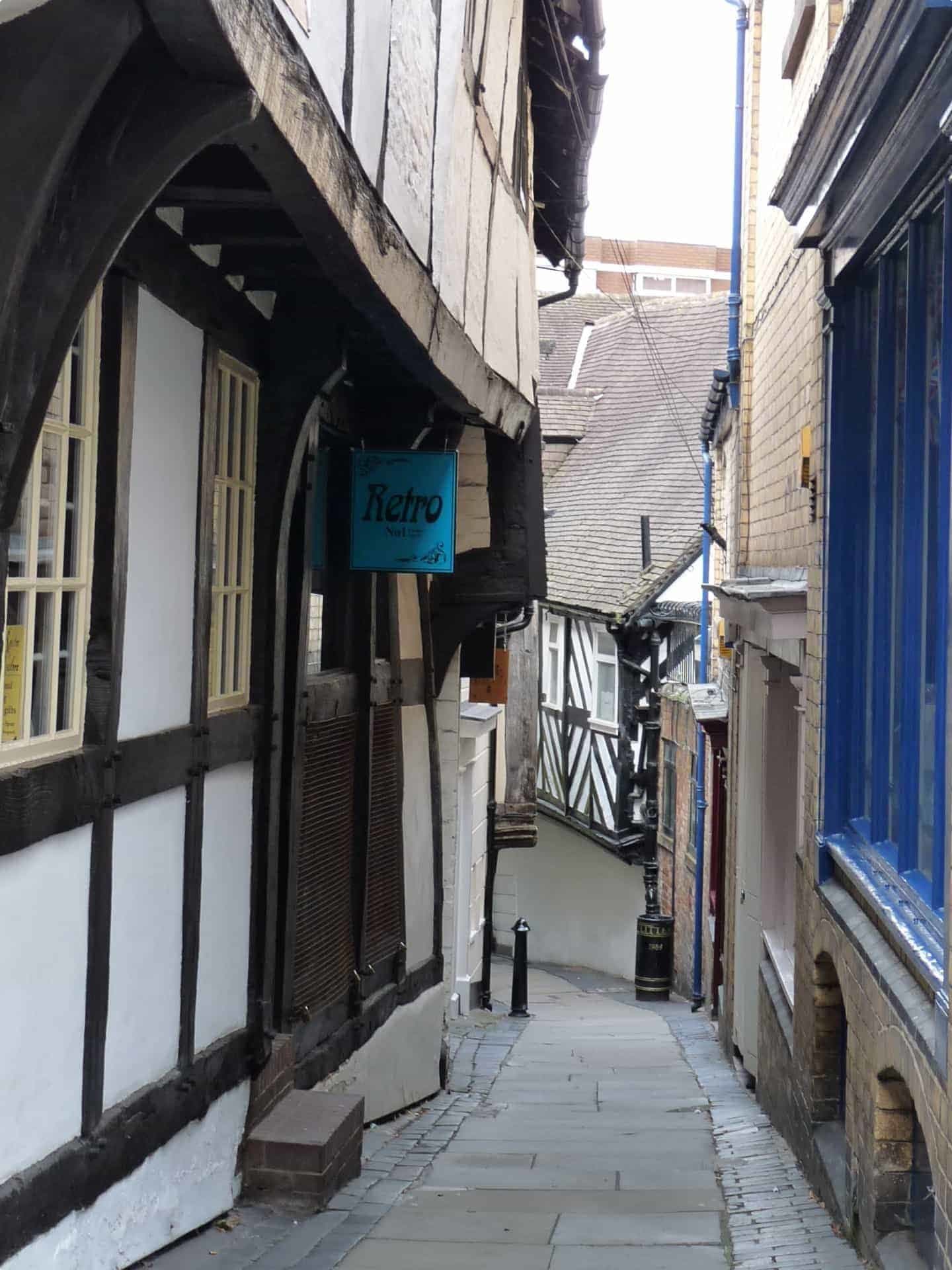
Shrewsbury
Shrewsbury is located on a loop of the Severn River just a few kilometres from the Welsh border in Salop (Shropshire). It is a beautiful historic market town with many black and white, half-timbered houses and is the birthplace of Charles Darwin (1809). A monument to this great natural scientist is located near the Shrewsbury Library. Wander through cobbled alleyways (shuts) and streets of the town to see the special floral displays and enjoy the local atmosphere.
Just to the east of Shrewsbury is a new town, Telford, built in the 1960s and 1970s and named after Thomas Telford. As mentioned above, it was Telford who took a leading role as an architect and engineer with the development of British canals and in the building of many significant roads and fine bridges throughout the country.
Atcham Village, just south of Shrewsbury, has an example of a beautifully graded, seven arch bridge which was built by John Gwynne. This bridge was constructed about 1770, and later carried Telford’s refurbished Holyhead Road from London.
The first cast iron bridge
The first cast iron bridge construction was at Iron Bridge township (part of the unitary district of Telford), across a gorge of the River Severn. The bridge was planned by Robert Pritchard and opened in 1781. The project, made possible through the locally developed blast furnace, was just the start of a plethora of constructions to take advantage of the new advances in iron production led by the three Darby generations at Coalbrookdale, located just north of the Iron Bridge.
The River Tern is a tributary of the Severn River, and it was at Longdon-upon-Tern, between Telford and Shrewsbury, that Thomas Telford constructed the first navigable cast iron aqueduct. The 57 metre long aqueduct was completed across the Tern valley in 1797 to carry the Shrewsbury Canal across the Tern. The remains of the canal, abandoned in 1944, can be seen as an embankment as you walk across the paddock toward the now isolated aqueduct.

Derwent Valley Mills
The Derwent Valley Mills is a World Heritage site, conserving the birth place of the factory system through a series of mill towns and a canal precinct.
Market Drayton was Telford’s last major planning project. It is located on the Shropshire Union Canal that connects the Mersey River near Liverpool, and Wolverhampton near Birmingham. The small town in North Shropshire has a long history with its Wednesday markets – they date back 750 years. Travel east from Drayton to cross another historic north-south canal, the Trent & Mersey, on the way to Derbyshire’s Derwent Valley of the Peak District. The site here preserves the very earliest of spinning machinery for cotton and silk, factory buildings, a canal, housing and other examples of urban settlement built specifically for factory workers.
Cromford is just one of many villages and factory sites developed by Richard Arkwight in this valley, starting in 1771. The conserved buildings are the first ‘modern’ style factories built along with housing constructed for the mill workers and their families. The railway to this valley, constructed as part of the ‘railway mania’ phase, was to reach Belpar in 1840 via an interesting cutting with eleven bridges designed by George and Robert Stephenson. It progressed north to Cromford by 1849.
Ellesmere & Llangollen
Ellesmere is yet another pretty market town with Saxon origins located close to the Welsh border. The town is situated adjacent to the Mere (one of many local shallow lakes that formed in depressions after the last ice age) on a spur of the Llangollen Canal. Telford lived here during the building of the Llangollen (Ellesmere) Canal between 1793 and 1805 and he had a house built for himself just off the canal near the current Ellesmere Depot and Yard (for boat repairs). Recent work has refurbished the Ellesmere wharf area at the end of a short spur off the main canal.
Chirk Castle, in the Wrexham District of North Wales was built between 1284 and 1310 for Edward I. It is now owned by the National Trust. The Castle was one of many similar structures along the Welsh Marches, built as a symbol of power and to defend England against the marauding Welsh. It was bought by Sir Thomas Myddleton in 1595. The castle commands superb views, particularly to the east. It boasts an award-winning garden with lots of topiary, along with its fascinating interior.
The Llangollen Canal
The Llangollen Canal passes through Chirk, and local work was completed here by Telford and Jessop around 1801. In addition to a long tunnel, Telford also had to build Chirk Aqueduct to cross the River Ceiriog. It consists of ten 12-metre arches. This large feature is outstripped in size, however, by the Pontcysyllte Aqueduct just a few kilometres upstream across the River Dee. Like many other canals in Britain, the Llangollen Canal is also known by alternate names, including the Llangollen Branch of the Shropshire Union Canal, and the Welsh Canal or the Welsh Cut. Further downstream this canal is also referred to as the Ellesmere Canal.

Snowdonia & Anglesey
Prior to 1826, coach travel to and from the Irish ferry at Holyhead was made quite arduous by having to cross the Menai Straits between mainland Wales and the island of Anglesey. Pressure came to bear on the government to improve the situation, especially for the mail coach service. In these times, a slow ferry across the tidal Straits was used for some road traffic, but cattle had to be swum across at times of low tide. A 15 year long road upgrade was undertaken by Telford to improve the London to Holyhead road. He built new surfaces, improved gradients and solved the strait crossing with the Menai Suspension Bridge, in a project that took six years.
Today, much of the road between Llangollen and the Menai Bridge still follows the route surveyed and improved by Telford. His monumental wrought iron and stone suspension bridge was an engineering triumph completed just before his 70th birthday. This was the first modern suspension bridge in the world and it still carries large volumes of traffic.
The West Highland Railways
Blaenau Ffestiniog was the industrial centre for the largest slate mine in the world, a mine which had 80 kilometres of underground railway on 26 levels. Today, the town holds less than half the population of its former 12,000 in Victorian days. Tailings from the slate mines cover the surrounding mountains. Sections of the town near the railway station are currently being rejuvenated.
It is possible to take a 21.7 kilometre train journey through forested and mountainous scenery, with several interesting twists and turns. This is a narrow gauge (1 foot 11 ½ inches) line originally built to haul the slate trains to the coast for export. Fortunately, steam power replaced gravity and horses by 1863. Pass through the extensive Snowdonia National Park and stop to enjoy a view of Mount Snowdon. At 1,085 metres, it is the highest mountain in Wales and England. More information on the West Highland Railways can be found here.
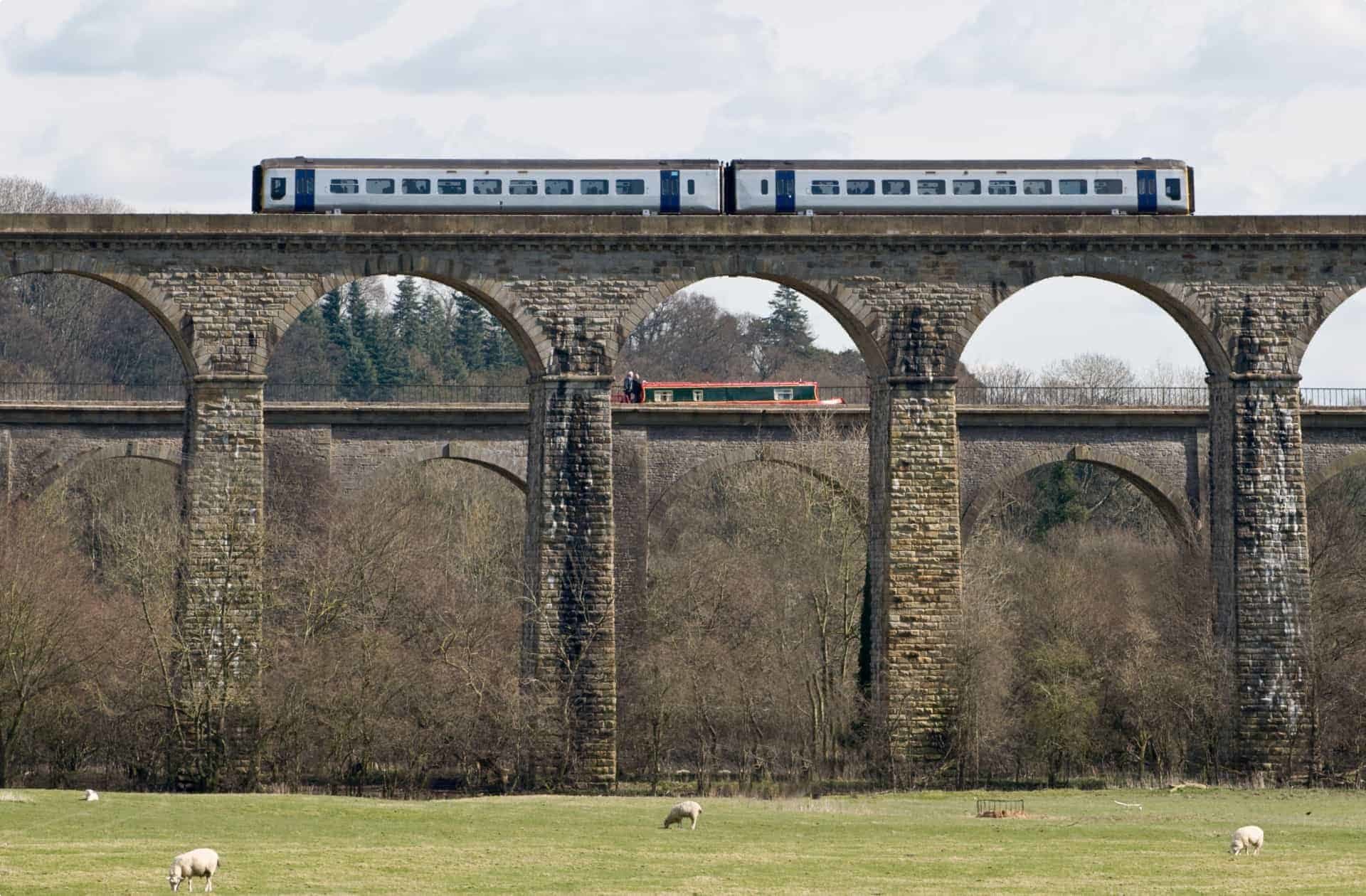
Around Llangollen
In 2009, an upper section of the Llangollen Canal, between Horseshoe Falls and the Chirk Aqueduct, was inscribed on the World Heritage list. Once again Telford, working with William Jessop, was instrumental in the engineering side of the canal construction and today we see one of the greatest achievements of the time.
Shropshire Union Canal Horseshoe Falls is a weir, built in 1806 on the Dee River, used to divert water from the upper reaches into the Llangollen Canal stream. This creates a flow into the canal and water is carried from here via Ellesmere to the canal terminus just north of Nantwich. Here, it joins the south-north Shropshire Union Canal (also known as the Birmingham Liverpool Junction Canal). By having this river off-take upstream from Llangollen, Telford was able to run the canal water in a channel around the contour well above the Dee valley floor, but this presented a challenge to get the canal across the Dee Valley to follow the line eastward via Ellesmere!
The ‘Canal in the Air’
One of the most impressive sites is viewing ‘the canal in the air’ at Pont Cysyllte Aqueduct. Here, Telford bridged the Dee River valley with huge stone arches, upon which he assembled an iron aqueduct trough and a towpath. Our Britain’s History through its Canals and Railways tour includes the opportunity to see this mighty edifice from the valley and to travel along the canal in a narrow boat.
This longest and highest aqueduct in Britain certainly has impressive dimensions: it is 307 metres long; it has 19 arches (18 spans), the tallest being 37 metres above the river, and the water flows in a cast iron trough across the span. The aqueduct has a horse towpath/walkway on its eastern side and like most of the canals seen during the program carries only narrow boats which are 70 to 72 feet long and 6 foot 9 inches to 7 foot 2 inches wide.
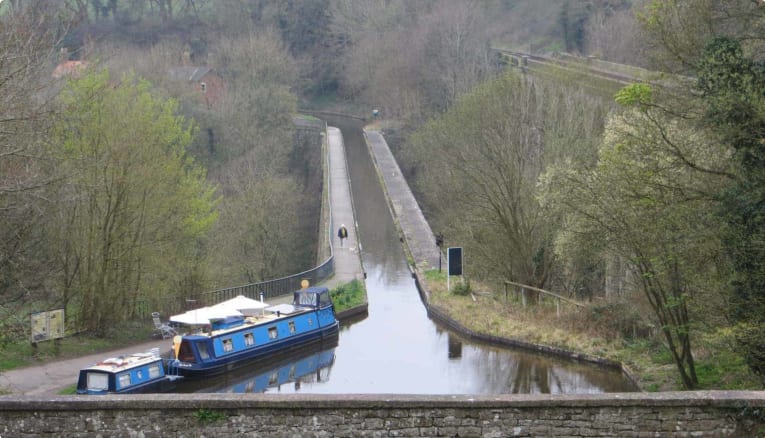
Llangollen to Liverpool
The ancient city of Chester is located on the north side of the River Dee, and the Shropshire Union Canal. The city was once a major Roman Fort and the amphitheatre, and much of the city wall stems from this time. The legion based here was charged with the suppression of the warrior queen Boadicea. Later, Chester became a main trading port on the Dee and was raided by the Vikings who travelled upstream in their longboats. By the 15th century, the River Dee had silted up, and so seaborne trade diminished. Chester’s streets, The Rows, date from the 14th century.
The Shropshire Union Canal was Telford’s last major work and was completed after his death in 1874. The canal completed a major south-north link for the English canal system. It ran from Birmingham to Port Ellesmere, so joining the Mersey and the Severn Rivers, and with many spur canals along its way, including the Llangollen Canal.
The National Waterways Museum has a large collection of canal boats and barges, a number of exhibitions depicting life on the canal, the range of goods carried on the canals, stables for the tow-path horses, active lock gates and all the other facilities needed for canal trade and boat maintenance.
Port Sunlight
In 1885, brothers William Hesketh and James Darcy Lever bought a small soap works in Warrington. They teamed up with a chemist to develop a new kind of soap, made from glycerine and vegetable oils rather than animal-based tallow. By 1887, they began searching for a new site on which to expand their soap-making business. They purchased 56 acres of land south of the Mersey River. It was selected for its prime location between the river and railway line. This site was to become Port Sunlight.
It soon became home to not only the soap works, but a model village built to house the employees. Construction of this village commenced in 1899, and by 1914, 800 houses had been built. Public buildings, such as a church and swimming pool, were also provided for the 3500-strong population. William Lever, who closely supervised the development, introduced welfare schemes. He provided for the education and entertainment of his workforce. His vision was for a profit-sharing system, in which business relations were “Christianised” and made social, too. Port Sunlight today is a historically significant area. Each block of houses was designed by a different architect, providing great insights into the fashions and materials of the time. They feature details like carved woodwork and masonry, and leaded glazed windows. Some were built in the Flemish style, using bricks imported from Belgium.
William Lever played a significant role in Britain’s Industrial Revolution. Archival footage of his life can be found here
Liverpool
Shipping trade still occurs in Liverpool but much of this is from reconstructed docks with, for example, a modern (completed in 2008) passenger terminal and other recent facilities for roll-on/roll-off and container handling. Some of the old dockland, such as Albert Dock, has been revitalised for accommodation, shopping, bars, and museums, while many of the grand shore-side buildings are heritage-listed and have been restored to their former magnificence.
In September 1830, Crown Street in Edge Hill, Liverpool and Liverpool Road, Manchester, were joined by the world’s first intercity railway using steam locomotives. Lime Street Station, Liverpool, was more central than Edge Hill but was only accessible in these early days by hauling carriages up to the station with stationary winding engines. As cuttings, tunnels and locomotive power improved, Lime Street Liverpool became the main Liverpool terminus as it is today.
The Stephenson family
The Stephensons won the right to supply the first steam engines for this intercity service using their Rocket engine during the Rainhill Trials. George Stephenson was also heavily involved in the construction of the twin lines connecting the two centres. His design had to overcome the difficulties of swampy land, steep gradients such as those into Lime Street, and skirting around the land of aristocratic landholders who did not want the railway to pass through their property.
It so happened that what had been built as a line to speed up the transit of goods between Liverpool and Manchester (replacing slow canal transport) was so popular that passenger travel became a major form of income for the Liverpool & Manchester Railway (L&MR). The first freight trains ran on the line in December 1830, hauling cotton, oatmeal and malt to Manchester, with Staffordshire pottery, clothing and salt into the docks in Liverpool. Soon, mail and livestock from Ireland were on the manifests.

Liverpool to Windermere
The Lune Aqueduct is located on the way north to Windermere in the Lake District. A most impressive railway viaduct at Ribblehead, is inland from here.
Morecambe and Windermere were just two of many locations that became popular as holiday destinations once the phenomenon of ‘railway mania’ had gripped Britain in the 1840s. Investors, speculators and railway companies realised that the railways as a form of public transport were popular, and that wage earners had disposable income. With newly-concentrated populations of working people in Liverpool and Manchester, the seaside at Blackpool, Morecambe and the Lake District at Windermere became popular destinations for day-trippers and holiday makers. People took advantage of locations that had once been the preserve of the rich and privileged. By 1850, some 500, 000 people left Manchester by rail during an August holiday week.
The Lancaster Canal
Unlike many of the other canals with their lock gates and lifts, the Lancaster Canal was built along the land contour, essentially eliminating the necessity of locks. The canal was engineered by John Rennie to carry coal, lime, slate and timber, and passengers, and ran between Kendall and Preston following a rather sinuous route. This canal was to have continued south to Wigan (near Manchester) but money ran out and construction was stopped without an aqueduct over the Ribble River near Preston. Paralleling the L&MR and the ‘railway mania’, this had been one of the many constructions from the ‘canal mania’ phase of British transport history, between 1790 and 1810.
Unfortunately, other than a branch to the sea port at Glasson, this canal was not then linked to the rest of the English canal network. On a positive note, today, most of the canal has been restored for recreational use. A spur canal, the Ribble Link, was constructed in 2002 near Preston – so connecting the isolated Lancaster Canal to the greater part of the canal system. This was the first new canal built in 95 years.
A ‘Wonder of the Waterways’
One of the most aesthetically-pleasing features of the Lancaster Canal is the Lune Aqueduct, described as one of the “wonders of the waterways”. This was engineered in 1796 by Rennie and was constructed by architect Alexander Stevens. Today, it is constructed with concrete but was originally a stone structure. It has five arches across the River Lune and, as a Grade 1 heritage building, was recently restored at a cost of 2.4 million pounds thanks to the Heritage Lottery Fund, British Waterways, British Heritage and the local Lancaster Canal Trust.
The 24-arch, curved Ribblehead Viaduct was built between 1870 and 1874 in the North Yorkshire Dales to carry the Settle to Carlisle railway across the Ribble valley. It was saved from demolition in 1960. It is now repaired and maintained and carries a single line across the valley. The viaduct is some 440 metres long and this impressive structure stands 32 metres above the valley floor at it deepest point.

Windermere & the Lake District
At the Lake District, experience some of the mountain and aquatic scenery that has attracted visitors since Victorian times. Much of the landforms in this north-western part of England were derived from glacial activity in the last Ice Age, which formed valleys now occupied by lakes. Many of the rivers, flowing through the lakes, radiate out from a dome formed by the earth’s movement. This is centred near Scafell. There are an endless number of walks in the district with everything from gentle lakeside paths to high hill and mountain climbs through the Lake District National Park. One of England’s oldest scenic railways, the Ravenglass Eskdale steam railway, offers spectacular views of the Lake District from another angle.
Historically, the Vikings roamed much of this area. The 4000 year old circle of standing stones at Castelrigg suggests that people of the Neolithic Age used the Lakelands before them. Like many other beautiful parts of England, the Lake District was home to Romantic Poets and writers such as Wordsworth, Coleridge, Southey and Beatrix Potter, while art critic and writer John Ruskin was also a local resident. It is recorded that Wordsworth expressed annoyance as the Lake District, once his quiet exclusive reserve, grew in popularity! Similarly, these sentiments were also expressed at many seaside locations by the rich and privileged once the ‘masses’ began to be given access to these locations via the newly-built railway system.
Windermere to Fort William
From the Lowlands of Scotland to the Highlands: skirt around several other inland and sea lochs before reaching Fort William at the head of Loch Linnhe. Fort William developed as a township beside a fort in the times of Oliver Cromwell. Its name derives from William of Orange, who reigned over England as King William III from 1689. As King of Scotland, he was known as William II.
These days, Fort William is a tourist centre at the foot of the highest mountain in the British Isles, Ben Nevis (1,344 metres), and just north of the historic region of Glen Coe. It is close to the Great Glen and the Caledonian Canal and offers access to the west via “the Road to the Isles”. Fort William is also the eastern terminus of the West Highland Railway line. The railway from Fort William to Mallaig follows a similar path to the ‘Road to the Isles’.

Fort William to Mallaig & Stirling
There are several superlative bridges, tunnels and the 21-arch, curved Glenfinnan Viaduct along the West Highland Railway between Fort William and the Mallaig. A one-way, 67 kilometre journey can be taken aboard a steam or diesel locomotive that has to negotiate several steep gradients and tight curves. After passing the deepest Scottish freshwater body, Loch Morar, finish at the deepest European seawater loch, Loch Nevis, on approach to Mallaig.
The Caledonian Canal
The Caledonian Canal, near Fort William, was built so that shipping could avoid the rough conditions off the north-west coast and save travel time. Construction was under Thomas Telford’s control and began in 1804, but was not completed until 1822. Building and economic difficulties stretched out the planned construction period for Telford and by the time it was finished, average ship size had increased beyond the lock’s dimensions. The canal was still used by small craft, however – including during WWII.
Today it is popular with recreational sailors. The Caledonian Canal construction runs south from Moray Firth near Inverness to Loch Linnhe. It passes through several lochs of the Great Glen including Loch Ness, Loch Oich and Loch Lochy. A change in water level at Banavie required Telford to build a great flight of 8 locks (Neptune’s Staircase) as the water dropped from Loch Lochy down to Loch Linnhe, at sea level.
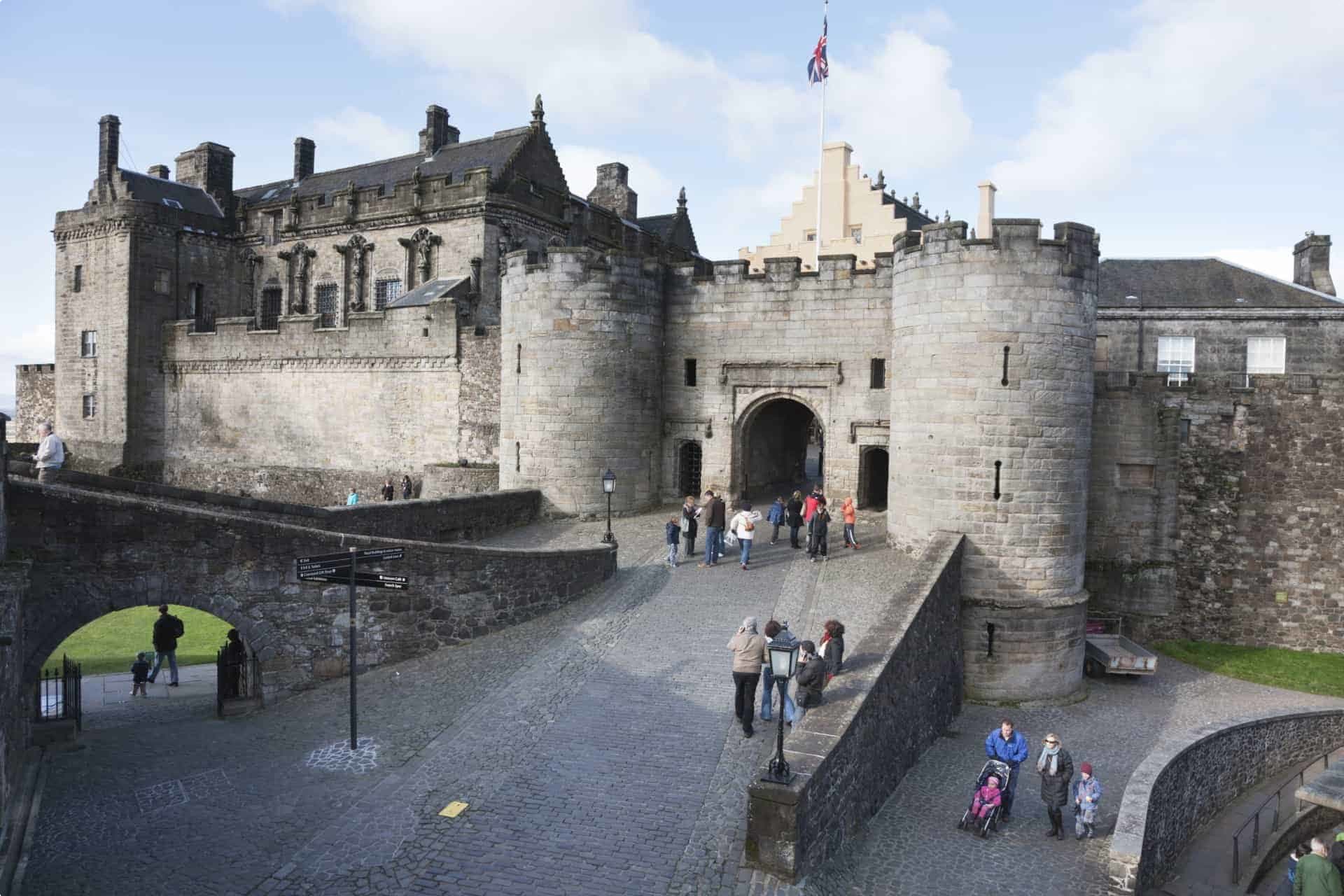
Stirling to Durham
Stirling Castle has roots going back to the 12th century. Most of what we see today was built between 1490 and 1600. It is one of Scotland’s largest castles. Set atop Castle Hill, it is surrounded by steep cliffs. This location was strategic – the castle guarded what was, until the 1890s, the farthest downstream crossing of the River Forth. Refurbishment work has been ongoing within the Castle since 1990. The Great Hall was completed in 1999, the Royal Palace in 2011 and a massive project to remake some of the Palace tapestries was completed in 2013.
Falkirk (and the Falkirk Wheel) is located roughly half way between Glasgow and Edinburgh. It is located on the upper reaches of the Firth of Forth, the estuary of the Forth River. The Forth and Clyde Canal passes to the north of Falkirk and, as the name suggests, it connects the Clyde River (and the Atlantic Ocean) in the west with the Forth (and the North Sea) in the east.
The 56 kilometre long, lock-free Union Canal runs at a higher level between south Falkirk and Edinburgh. Rather than locks or a vertical lift like that at Anderton, modern engineering has enabled both canals to be connected today by the Falkirk Wheel. This is an attractive piece of machinery built in 2002 that lifts or lowers boats in a circular motion between the two canals. Seven authorities were involved in this project to reconnect Glasgow and Edinburgh by canal.
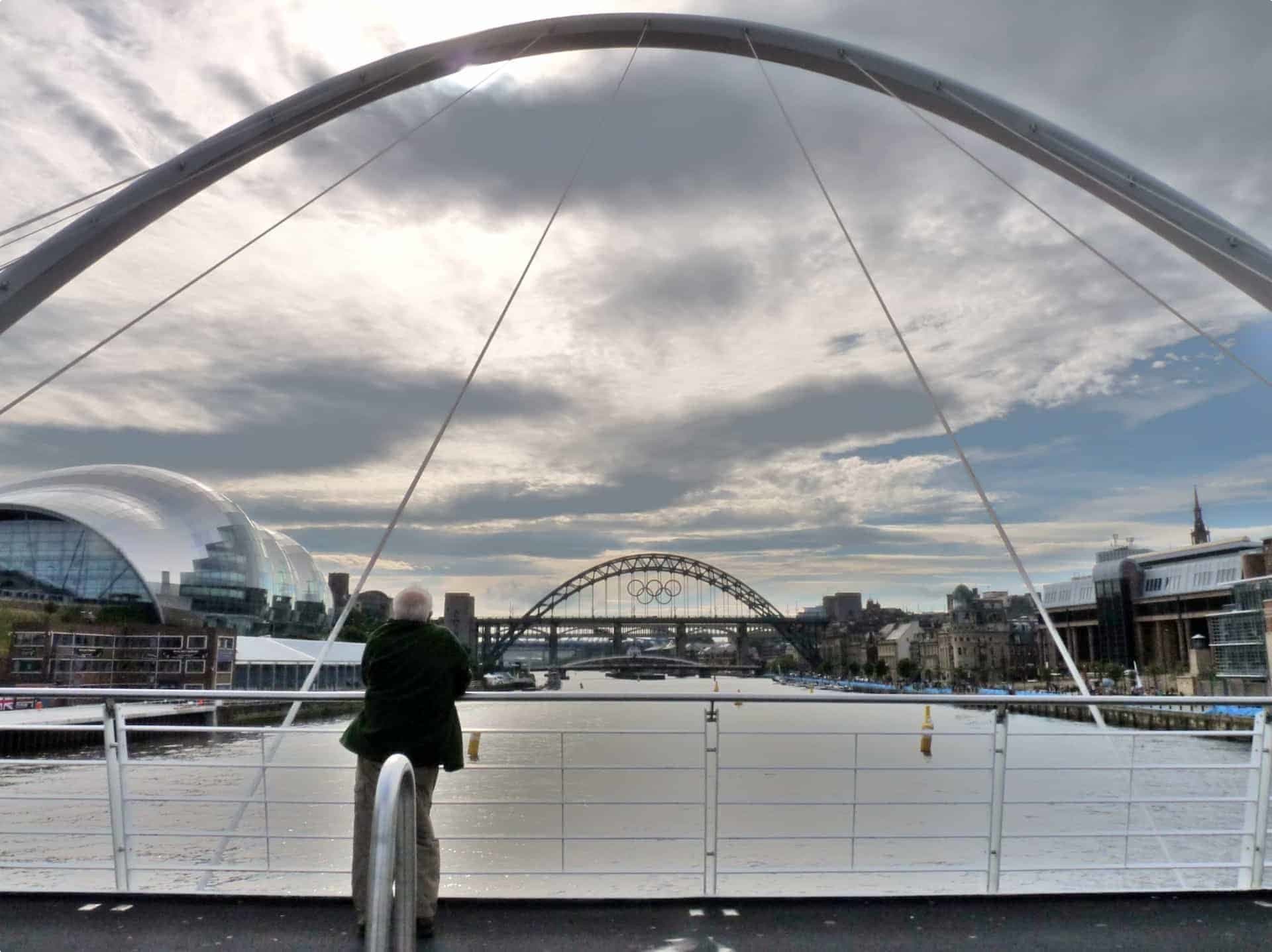
Newcastle & Durham
Newcastle-upon-Tyne was first settled by the Romans. It was a staple (i.e. wool-manufacturing) town in the mid-1300s, but made its name through a monopoly on the export of coal to London in the 1500s. In the 18th century it was a major centre for printing, and industrial development through ship building and heavy engineering made it a hub during the Industrial Revolution. It was here that George and Robert Stephenson, with three other investors, established the first purpose-built locomotion factory, and where they experimented with and built most of their steam engines. Robert was to develop his famous Northumbrian and Planet prototypes here in the late 1820s.
The Planet was technically much improved over the Rocket’s capabilities and the Northumbrian was used on the L&MR official opening with a ‘payload’ of 700 guests. Trains from these works were exported all over the world and by the time of Robert’s death in 1859, this factory was the largest employer in Tyneside. The factory was moved south to Darlington in 1902 and the Tyneside site closed in 1904.
Like Manchester and Liverpool, Newcastle city has seen a major revival program featuring the Quayside and the city centre. The miles and miles of docks and factories that once lined the Tyne have been demolished or otherwise modified for modern purposes, including the Millennium Bridge, housing and civic use.
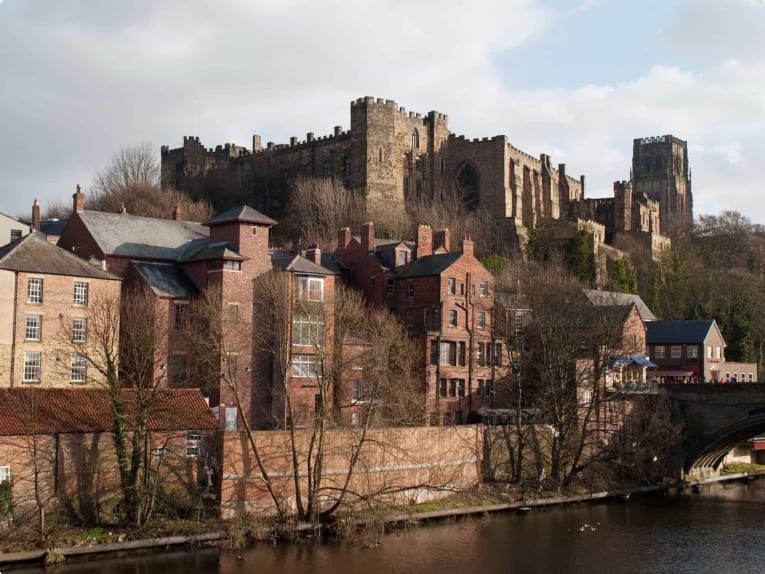
Durham
Durham is the seat and administrative centre of County Durham. Durham is the religious, educational and cultural centre of the County; it is also the busy hub of the surrounding agricultural area. The older part of the city is located near the River Wear with a Norman Cathedral that looks over much of the city, set high above a u-bend in the river called the Peninsular. The Cathedral’s architecture is one of a kind and both the Cathedral and nearby Castle were listed as World Heritage Sites in 1986. Durham was founded as a defensive and religious centre, protecting northern England against the Scots and housing the shrine of the 7th century St Cuthbert in its cathedral. The name “Durham” originates from “Dunholm”, or “island on a hill”, where Bishop Aldhun built the first shrine to St Cuthbert in 995.
Durham Castle, which predates the Cathedral, is also located on the Peninsular and it has now become a college within the University complex. So Durham played an important part in the history of northern England and these buildings illustrate the immense power of the early Prince Bishops.
Darlington
The Stockton & Darlington Railway (S&DR) was established in 1825 to carry coal and passengers to Stockton-on-Tee: a navigable part of the Tee River. This was the first steam-worked public railway using both locomotive power and winding engines.
The Head of Steam Museum is actually located on the original, 1825 line. It houses many railway exhibits, the most significant of which is Stephenson’s Locomotion No.1, preserved since 1857 and displayed near this location since 1892. Locomotion No.1 was the first engine to haul passengers in September 1825. Originally built for the S&DR, the Locomotion No.1 design was quickly modified by Robert Stephenson and many of the changes were incorporated into the Rocket.
Most of the other features on exhibition at the Head of Steam also originate from the 1820s, and demonstrate why Darlington is considered the birthplace of the railways. Another early engine is the Derwent – an 1842 engine which is the earliest remaining engine built at a Darlington factory.
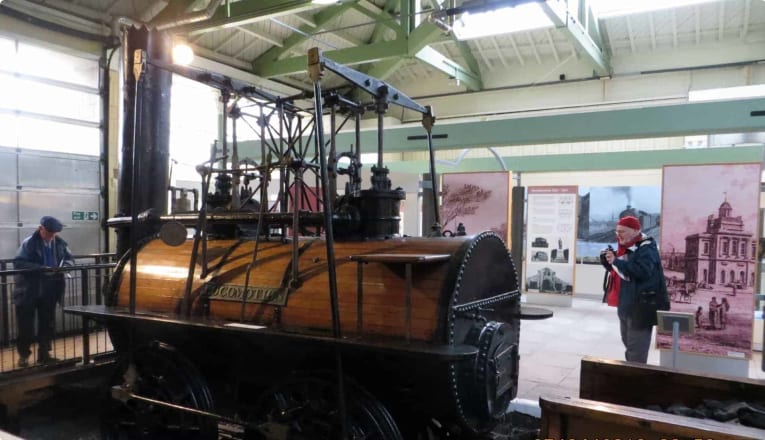
Durham to York
To the south of Darlington and Stockton is the North York Moors National Park, a large expanse of heather moorland which has on its eastern edge the coastal towns of Whitby and Scarborough. Travel to Whitby and then cross the north Yorkshire Moors to Pickering by the North Yorkshire Moors Railway (NYMR). This line was established in the 19th century from Whitby and has been preserved by private funds.
In Whitby, explore the Captain Cook Museum and climb the hill for a look at Whitby Abbey. For Australians, possibly the best known part of the history of Whitby is Cook sailing out, as commander of the Endeavour in 1768, to make important discoveries in the South Pacific Ocean. Another element of Whitby’s history took place more than 1100 years before Cook sailed. It was here in 663 that the English and the Roman Churches established a method for determining the date of Easter. The Synod met in the Whitby Abbey to make this determination; sadly the Abbey is no longer intact. It was destroyed by the Danes (Vikings) and although subsequent building by the Normans took place, the building was stripped and all that remains today are the 14th century ruins which are said to be the inspiration for Bram Stoker’s novel, “Dracula”.
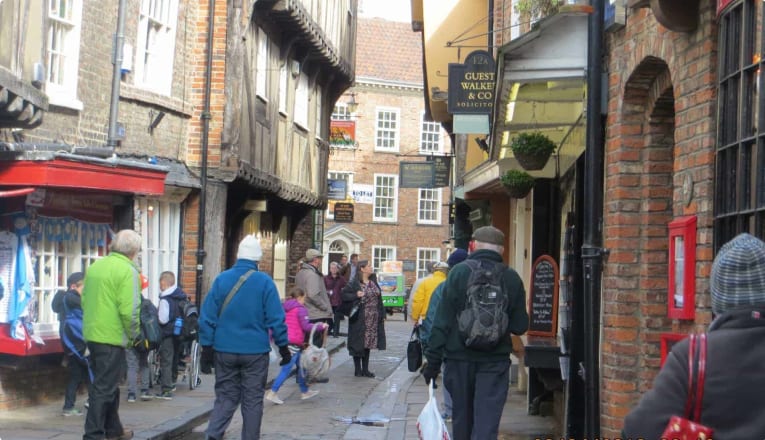
York
York is located in North Yorkshire at the confluence of the Ouse and Foss rivers. The city’s name derives from the Old Danish word Jorvick. It is an industrial, commercial and transport centre. Factories here produce chocolate, construction and engineering products, and scientific instruments. There is substantial office employment in insurance, health care and the rail industry. York also has a growing sector in the field of bioscience. Tourism is important to York’s economy, as almost 4 million people visit the city each year.
York has many mediaeval architectural landmarks, of which the most prominent is the cathedral of St Peter, commonly known as York Minster. Built between the 13th and 15th centuries, the Minster is a magnificent example of Gothic architecture and contains more mediaeval glass than any other church in England.
The medieval city
The medieval city is encircled by well-preserved walls (largely 14th century), which contain four of the main fortified gates (called bars). Remains of two Roman towers may also be seen. These defences are the most complete in England, and incorporate part of the walls of the Roman fortress and some Norman and medieval work, as well as 19th- and 20th-century renovations. The entire circuit is approximately 2.5 miles (4 km), and encloses an area of 263 acres (106 ha).
Among the city’s notable museums is the Jorvik Viking Centre, opened in 1984, which provides a reconstruction of life in York when it was inhabited by the Vikings, as well as a display of numerous artefacts found in archaeological excavations. Equally notable are the National Railway Museum and the Castle Museum, which is a museum about everyday life in Yorkshire.
In its early days, York was a road hub – being a major centre on the Great North Road. Today it has several A-class road connections radiating from it. It had a good navigable river being originally tidal with connections to the sea at Hull, but a downstream lock at Naburn now makes the Ouse at York non-tidal. An economic downturn, caused by the decline of the wool trade, was arrested in 1839 when York developed as a rail centre. The railways continue to be important to York, both directly as a source of employment, and as a transport link to the rest of Britain.
Bourneville chocolate
The Industrial Revolution led to a great increase in employment within cities. People were drawn to the promise of higher wages, and sought to escape the increasingly bleak prospects held by rural life. But as metropolitan populations suddenly increased, the standard of living was adversely affected. Opportunities for advancement were not as plentiful as expected, and many families were forced to live in slum-like conditions. In 1879, George Cadbury, with his brother Richard, made the decision to move their chocolate-making business from the backstreets of Birmingham to the Worcestershire countryside. Named by the brothers for the river Bourn, Bournville became the site of a revolutionary social enterprise: the brothers provided affordable, quality housing for their employees. Cadbury pioneered a pension scheme, a joint works committee and staff medical service. He encouraged an active, outdoor lifestyle by incorporating parks and recreational areas. Schools, a hospital, and museum were also provided, thanks to the Bournville Village Trust, established 1900. This Trust continues to have international influence on town planning more than a century later. Cadbury remains one of Birmingham’s main employers; and Bournville, said to be one the nicest places to live in Britain.
York & district
The National Railway Museum is billed as the world’s largest railway museum. It has a huge collection of engines with up to 100 being on display at any one time. However, the museum has a wider charter with many other exhibits that reflect how the railways practically operated and who they provided for. Queen Victoria’s Saloon and the Royal Carriages, the fast Flying Scotsman and the distinctive Duchess of Hamilton engines, the ornate gates from Euston Station, a statue of George Stephenson, a replica of the Rocket and the Warehouse with a thousand surprises – are all skilfully displayed.
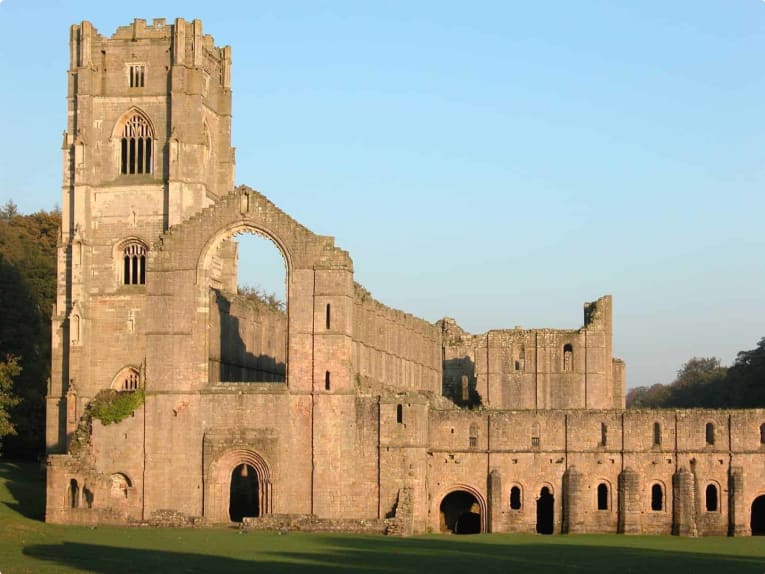
Fountains Abbey
The World Heritage-listed Fountains Abbey is a remarkable remnant from 1593 when Henry VIII ordered the dissolution of such abbeys. The great stone building that had begun in 1132 as a wooden church had its canonical ornaments confiscated, its high lead roof stripped, and its wall stones recycled elsewhere. The abbey is set in extensive park-like grounds near the River Skell. Today, we are left with extensive ruins, allowing us to imagine the magnificence of the abbey pre-1593 with its great cloister, chapter house, cellarium and associated buildings. Today, the original gatehouse for the abbey serves as a modern exhibition centre, providing information about the site.
Harrogate is a spa town with lovely public parklands and gardens. Its local spring water, which contains sulphur and iron, was considered a remedy for many ailments “from gout to lumbago”, and was drunk as a health tonic. Today these waters are considered unsuitable for human consumption! There were many springs in the area producing the water, and bath houses such as the Royal Pump Room were set up for bathing purposes. The attractive seasonal floral displays have won Harrogate prizes in the Britain in Bloom and Europe in Bloom competitions and the town is seen one of the most ideal places to live in the UK.
Birmingham
Birmingham is currently the largest city in the UK outside of London and was highly significant during the period of the Industrial Revolution. Industrial expansion in Birmingham started earlier than that of the textile-manufacturing towns of the North of England, and was driven by different factors. Other economies were based on a low-paid, unskilled workforce producing a single bulk commodity such as cotton or wool in large, mechanised units of production.
Birmingham’s industrial development, by contrast, was built on the adaptability and creativity of a highly paid workforce with a strong division of labour. These workers practised a broad variety of specialist trades and produced a constantly diversifying range of products, in a highly entrepreneurial economy of small, often self-owned workshops. This led to exceptional levels of inventiveness: between 1760 and 1850 – the core years of the Industrial Revolution – Birmingham residents registered over three times as many patents as those of any other British town or city.
The demand for capital to feed rapid economic expansion also saw Birmingham grow into a major financial centre with extensive international connections. Lloyds Bank was founded in the town in 1765, and Ketley’s Building Society, the world’s first building society, in 1775. By 1800, the West Midlands had more banking offices per head than any other region in Britain, including London.
Innovation in Birmingham
Innovation in 18th-century Birmingham often took the form of incremental series of small-scale improvements to existing products or processes, but also included major developments that lay at the heart of the emergence of industrial society. In
- 1709: the Birmingham-trained Abraham Darby I moved to Coalbrookdale in Shropshire and built the first blast furnace to successfully smelt iron ore with coke, transforming the quality, volume and scale on which it was possible to produce cast iron.
- 1732: Lewis Paul and John Wyatt invented roller spinning in 1732, a key development of the mechanised cotton industry.
- 1741: Paul and Wyatt opened the world’s first cotton mill in Birmingham’s Upper Priory.
- 1746: John Roebuck invented the lead chamber process, enabling the large-scale manufacture of sulphuric acid.
- 1765: Matthew Boulton opened the Soho Manufactory, pioneering the combination and mechanisation under one roof of previously separate manufacturing activities through a system known as “rational manufacture”. As the largest manufacturing unit in Europe, this came to symbolise the emergence of the factory system.
- 1780: James Keir developed a process for the bulk manufacture of alkali; these latter developments marked the birth of the modern chemical industry.
The industrial steam engine
Perhaps most significant, however, was the development in 1776 of the industrial steam engine by James Watt and Matthew Boulton. Freeing for the first time the manufacturing capacity of human society from the limited availability of hand, water and animal power, this was arguably the pivotal moment of the entire industrial revolution and a key factor in the worldwide increases in productivity that would proceed over the following century.
The Smethwick Engine, on view at Birmingham’s “Thinktank”, is the world’s oldest working engine. It was designed and built by James Watt in 1779.
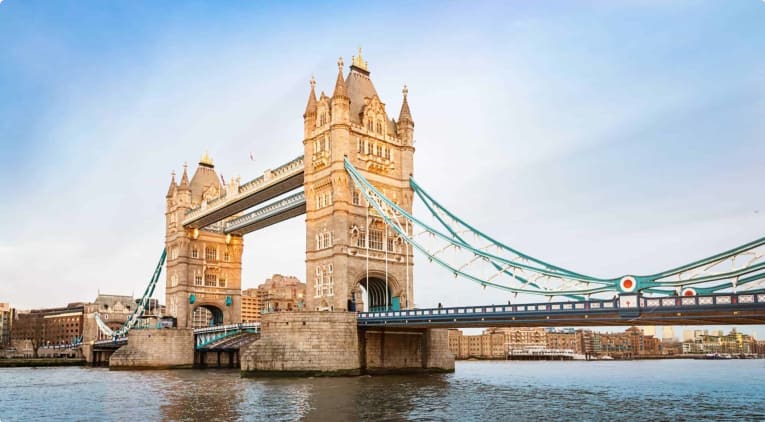
London
As the long distance railway companies developed their lines to and from London, many erected architecturally-grand buildings for the station platforms and offices, and often for an associated hotel, in dispersed locations around the city. Some of these stations and the original railways include:
- London Bridge was built for the first rail service in London, the London & Greenwich Railway in 1836.
- Euston, built for London Birmingham Railway in 1837
- Paddington, for Great Western Railway at it first site in 1838, and second in 1854
- Waterloo, for London & South Western Railway in 1848
- Kings Cross, for Great Northern Railway in 1852
- Victoria, for London, Brighton & South Coast Railway in 1860
- Charing Cross, for South Eastern Railway in 1864
- St Pancras, for Midland Railway in 1868, and
- Marylebone, for Great Central Railway in 1899
Today, of course, these terminals are also stops for the local above and underground services and some, like Euston service, also have an international function. This latter service to Europe first went to Waterloo, but this line could not handle the fast Eurostar trains and so a new line was developed to St Pancras. Victoria, too, had international links via the Continental boat-trains, but today the only international link here is via the 1980 rail-air terminal from Gatwick.
London rail today
This multiplicity of main stations in London may be paralleled to some degree with the six principal stations in Paris, whereas many other countries have relied on a single junction servicing their numerous country lines. Statistics show that in 1903, the London terminals handled 300 million passenger journeys. 100 years on, the number has grown to 400 million and rising.
Much of the original design of the terminals went far beyond creating a functional station. They also expressed the pride the company had in their transport product, serving as both a marketing tool and a status symbol. Throughout their life, the terminals have been modified and maintained. Recent interest in their heritage value, and the need to handle larger numbers of passengers, has seen some of these terminals undergo large refurbishment programs.
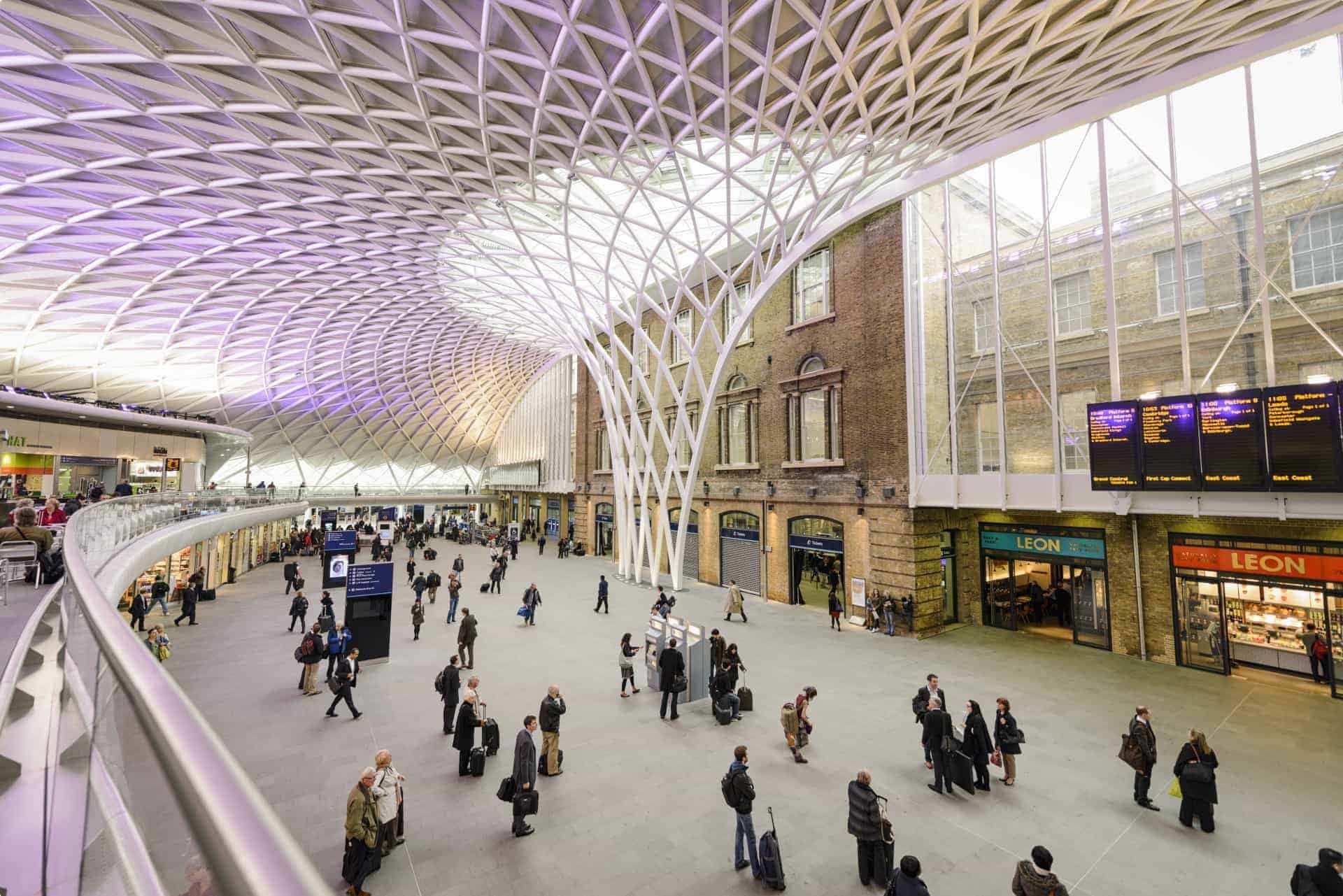
Driving change
The change from steam locomotion to diesel and electricity between 1959 and 1965, and the use of high speed trains, were factors that drove some of the more recent station alterations. Another change was that many of the railway companies either abandoned freight transport or moved their freight facilities out of the city centre. Just north of Kings Cross station, near the Regent Canal, for example, a very large space once devoted to coal drops, water towers, canal wharves and other freight handling depots is currently Europe’s largest inner-city regeneration site.
Some other examples of recent changes include:
- The impressive glass concourse between Kings Cross Station and the Great Northern Hotel. Better exposure of the 1852 façade and improvements to the train shed and platforms are part of a 400 million pound project that will benefit the 50 million passengers who use the station annually.
- At St Pancras International, the platform length was doubled for the Eurostar and a new passenger concourse constructed. The elaborately-decorated hotel that fronts the station was restored and the ‘new’ international station was opened by Queen Elizabeth II in 2007
- Euston station, London’s oldest terminal, is now in its third generation. The original stones that formed an arch and two lodges when built in 1837 were knocked down and removed in 1961. The gateways under the original arch are now exhibited in National Railway Museum, York. The building stones were recovered in 2009 and went toward reconstruction of the Arch and lodges at a new, nearby site.
- Marylebone was built for the last great line to London in 1899 two years before the death of Queen Victoria. It is located halfway between Euston and Paddington. Today it services few long distance trains but was originally a connection to Manchester. It had a grand hotel, the Great Central Hotel, built close by, which somewhat overshadowed the Marylebone station itself. This hotel has had multiple functions, including being the headquarters for British Rail after the railways were nationalised, but today it has reverted to being a luxury hotel. Compared to many of the other stations, the modest red brick frontage of Marylebone harmonises well with its surroundings.
The London Canal Museum
London Canal Museum is located on Battlebridge Basin off the Regent Canal and is housed in a building that originally served as an ice house for both storage and distribution of ice. It was then owned by Carlo Gatti who imported the ice from Norway by ship, with transport to this location by canal barges. The museum is quite small but has many exhibits, including illustrating life on a canal boat, the role of horses as towing animals, the London canal system, the functioning of locks, and of course, some of the history when the building was used by Gatti.
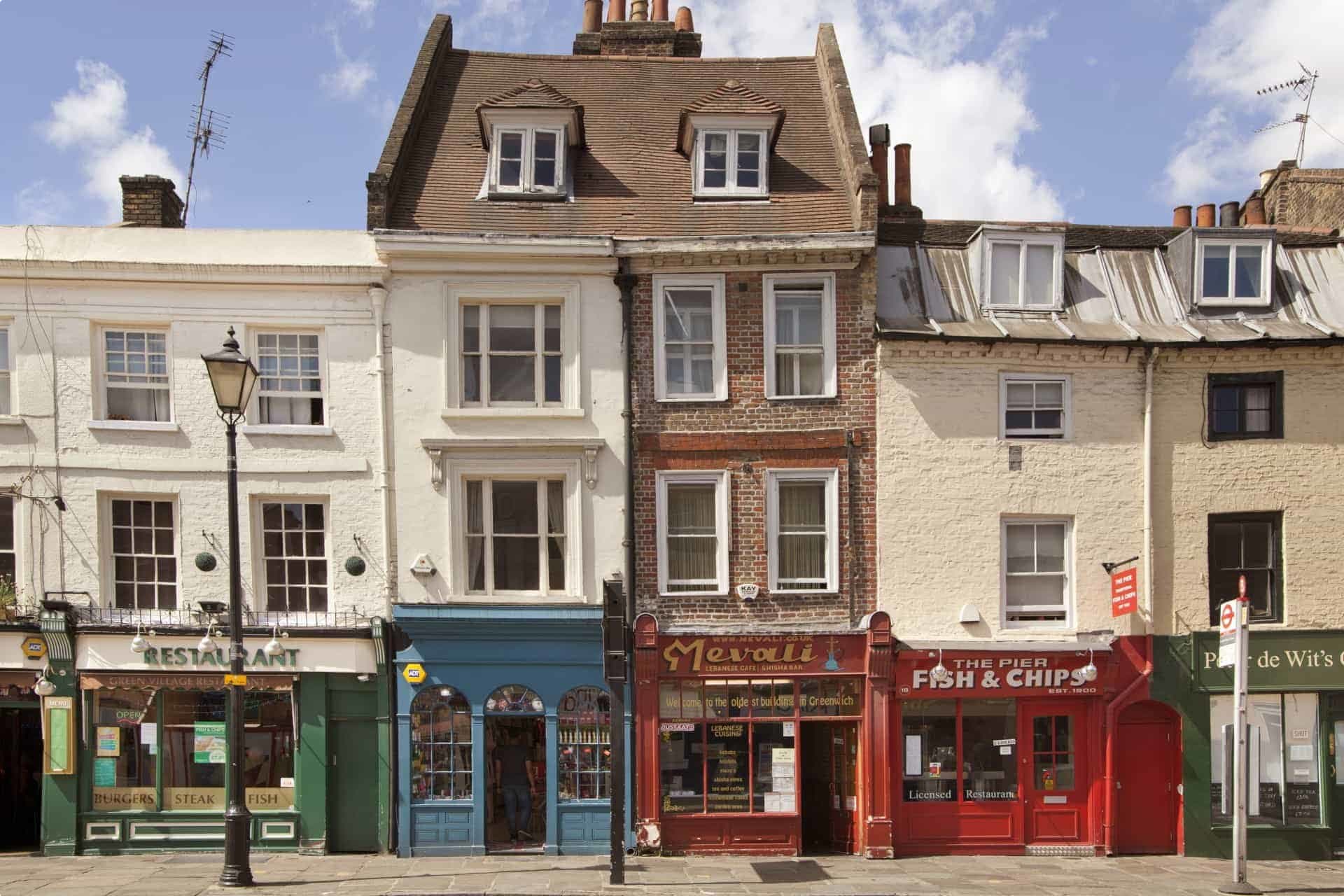
Greenwich
Greenwich, as noted above, was the destination of the first railway in London and is located on the south bank of the Thames east of London. During its construction pre-1836, a team of 400 navvies worked on the line, constructing the 878 large arches that were necessary on the 5.5 kilometres of line in order to avoid residences and busy streets. It is estimated that 60 million bricks were required for the job, with navvies laying about 100,000 per day.
The Royal Museum is a group title for the National Maritime Museum, Royal Observatory Greenwich and the Queen’s House. This location is a fitting conclusion to a tour of Britain’s railways and canals, given the central role that the London docks played in the import and export of goods, and its connections with the national canal network and railways. This Greenwich precinct was inscribed as a World Heritage site in 1997.
Britain’s canals and railways – small group tours
If this post has piqued your interest in the history of the Industrial Revolution in Britain, consider Odyssey Traveller’s educational tour.
Over 22 days, we visit the key sites associated with the history of the railway and canal systems. We travel from the midlands of England and North Wales, up the west coast to Scotland, before returning down the east coast to London. Odyssey Traveller’s Exploring Britain through its Canals and Railways tour is designed for senior and mature travellers who are interested in learning about the places they visit. Our small group tours include an experienced guide to provide context and access to locations off the beaten track. For more information on all of our tours to the UK, click here. If you would like to contact us about this, or any other of our small group tours, please call or send an email. We’d love to hear from you!
Related Tours
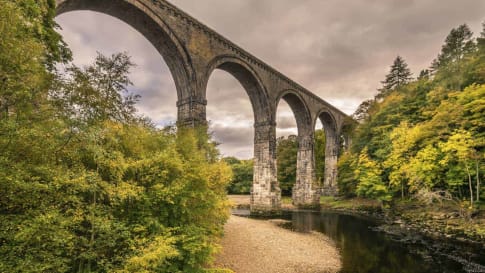
23 days
Oct, Apr, SepCanals and Railways in the Industrial Revolution Tour | Tours for Seniors in Britain
Visiting England, Scotland
A small group tour of Wales, Scotland & England that traces the history of the journey that is the Industrial revolution. Knowledgeable local guides and your tour leader share their history with you on this escorted tour including Glasgow, London, New Lanark & Manchester, Liverpool and the Lake district.
From A$17,860 AUD
View Tour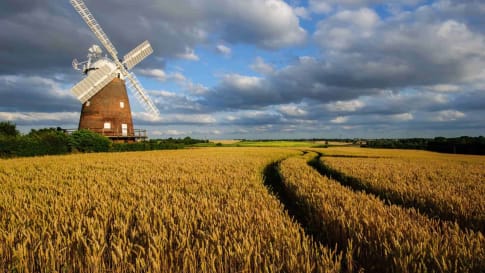
23 days
AprAgrarian and Industrial Britain | Small Group Tour for Mature Travellers
Visiting England, Wales
A small group tour of England that will explore the history of Agrarian and Industrial period. An escorted tour with a tour director and knowledgeable local guides take you on a 22 day trip to key places such as London, Bristol, Oxford & York, where the history was made.
From A$17,275 AUD
View Tour
22 days
Apr, May, SepAnglo French Tour | Normandy, Brittany, Channel Islands tour
Visiting Channel Islands, England
Our 21 night program has daily itineraries with plenty of authentic experiences provided by passionate local guides in the key destinations in France, Channel Islands and England for this small group of like minded people. For Solo travellers minimal single supplement applies for this European tour.
From A$18,995 AUD
View Tour
From A$13,915 AUD
View Tour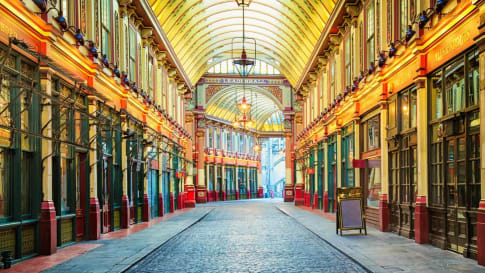
21 days
Sep, JunQueen Victoria's Great Britain: a small group tour
Visiting England, Scotland
A small group tour of England that explores the history of Victorian Britain. This escorted tour spends time knowledgeable local guides with travellers in key destinations in England and Scotland that shaped the British isles in this period including a collection of UNESCO world heritage locations.
From A$15,880 AUD
View TourArticles
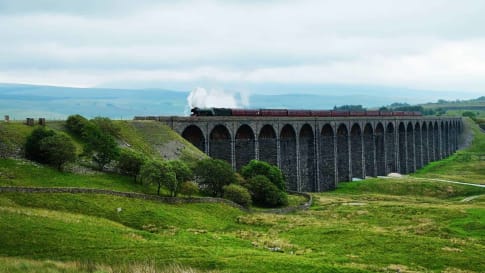
15 books on Britain's Industrial Revolution
Fifteen books on Britain’s Industrial revolution This reading list on Britain’s Industrial revolution complements Odyssey Travellers escorted small group tour that traces via the canal and railway network, the evolution of this monumental change in…
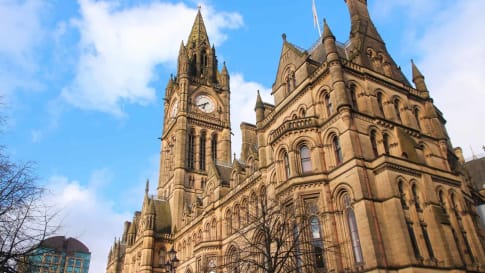
Bees in Manchester: a surprising symbol of the Industrial Revolution
Bees in Manchester: a surprising symbol of the Industrial Revolution The bee is an intriguing symbol for the city of Manchester. The city’s damp climate provided the ideal conditions for milling cotton. But this is…
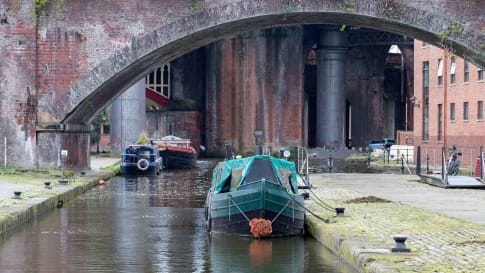
Britain: First Industrial Nation
Britain: The First Industrial Nation In the mid-18th century, the Industrial Revolution was largely confined to Britain. Historians and economists continue to debate what it was that sparked the urbanisation and industrialisation that would change…
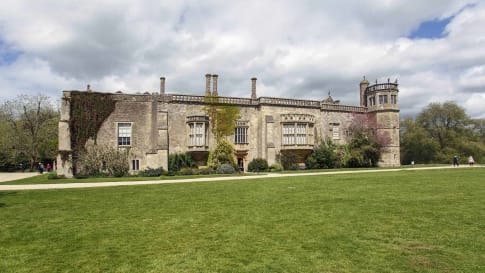
Britain’s National Trust role for successful small group history tours
Britain’s National Trust: Historic houses, gardens and natural wonders Britain is home to many attractions, many of them rich in the region’s history. Sites and artefacts are preserved beautifully, and […]
England's Liverpool: Port City, Architecture Marvel
Article for educational small group tours about the Port City of Liverpool. An Architecture Marvel from Georgian times, built on trade, some good, some horrific. Read and learn more before joining a tour for senior couples and mature solo travellers interested in culture, learning and the arts.

London's Victorian Architecture: The Definitive Guide for Travellers
Small group educational tours for senior couples and mature solo travelers with History tours including those examining the Industrial revolution, Victorian Britain the Gilbert and Sullivan era via the D'Oyle Carte family and the cities such as Glasgow, Liverpool and Manchester.

Markets of Victorian London
Article about the markets of London as part of a small group educational tour of England, Scotland and Wales as well as Europe. Collection of Articles about Victoria and her England including the industrial revolution for senior couples and mature solo travelers.
Personalities from Queen Victoria's Britain
Article for senior couples and mature solo travellers exploring Queen Victoria's Empire including Britain and the personalities. Supports small group educational tour about the monarch and the industrial revolution.

Personalities from Queen Victoria’s Britain
Article for senior couples and mature solo travellers exploring Queen Victoria's Empire including Britain and the personalities. Supports small group educational tour about the monarch and the industrial revolution.
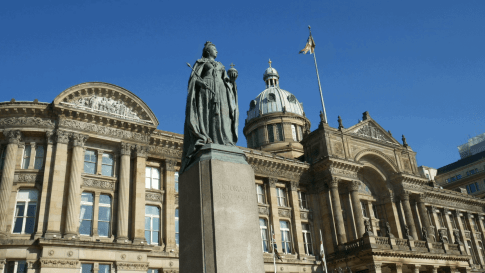
Queen Victoria's Britain: The Definitive Guide for Travellers
Article for educational small group tours of England for senior couples and mature single travellers. Queen Victoria, Britain's longest serving monarch through most of the Industrial revolution and rural life and the Empire is discussed in this article.

Travellers exploring Glasgow's Architectural Heritage
Article about Glasgow Architectural heritage, led by the Industrial revolution, in Victorian Britain, wealth flowed to Scotland to Glasgow and Edinburgh. See and learn on a small group tour for senior couples or mature solo travelers.
